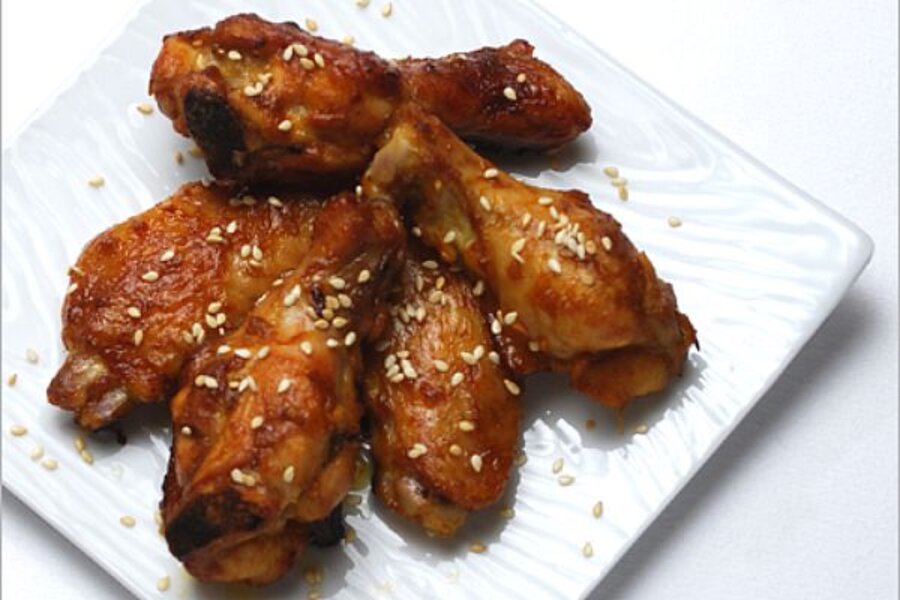Oven roasted wings
Loading...
The first time we had Korean fried chicken wings, we were at a rooftop bar in Manhattan. It was the Mé Bar on the 14th floor of the La Quinta Manhattan in Koreatown, with the Empire State Building rising high above us just a block away. And it was a single wing, generously pressed upon us by a table of enterprising New Yorkers who’d had them delivered to the bar (New Yorkers seem to be able to get just about anything delivered just about anywhere). We had smelled something spicy and delicious and asked what it was. They insisted we sample one.
The next day, we headed to the source for lunch – Kyochon Chicken, at Fifth Avenue and 32nd Street. How good were the wings? On our next visit to New York, we went straight from Penn Station to Kyochon, stowed our luggage in the corner and chowed down.
The wings at Kyochon are deep fried twice – ”double fried” – to render out fat and make them extra crispy, a process pioneered by founder and chairman Won-Kang Kwon. They’re then hand brushed with one of two signature sauces, Soy Garlic and Hot & Sweet. We order both and share them. And lick our fingers greedily before reluctantly using the provided wet naps.
But I don’t deep fry. I just don’t, for many reasons. If a recipe starts by measuring oil in inches of depth instead of tablespoons, I move on. So I opted for oven roasting. I knew I wouldn’t achieve Kyochon’s crispiness, but with plenty of aromatics and seasonings, my wings would be flavorful and have a little kick.
Korean Style Chicken Wings
Makes about 2 dozen wings
2 tablespoons gochujang (Korean hot pepper paste – see Kitchen Notes)
4 teaspoons sesame oil
4 teaspoons soy sauce
2 tablespoons rice vinegar
2 cloves garlic, minced
1 tablespoon minced fresh ginger
1/2 teaspoon cayenne pepper
2 pounds chicken wings and drumettes, from about 10 to 12 chicken wings with tips removed
1/2 tablespoon sesame seeds (optional, but recommended)
Marinate the chicken wings. Combine gochujang, sesame oil, soy sauce, rice vinegar, garlic, ginger and cayenne pepper in a medium bowl and whisk to blend. Place chicken in a gallon plastic zipper food storage bag and add the marinade. Seal bag and turn to coat chicken pieces evenly. Marinate chicken in the refrigerator for at least 1/2 hour and up to 3 hours, turning at least once. Remove chicken from fridge, leaving it in bag, and bring to room temperature, about 1/2 hour.
Roast wings. Preheat oven to 400 degrees F. Line a baking sheet with aluminum foil and arrange wings skin side up in a single layer so that they’re not touching. Reserve marinade. Roast on middle shelf for about 30 minutes or until chicken reaches an internal temperature of at least 165 degrees F. Meanwhile, heat reserved marinade in a small sauce pan to boiling, reduce heat to very low and simmer sauce for 5 minutes. If it gets too thick, add a tablespoon of water. About 20 minutes into the roasting time, baste chicken wings with marinade.
Also meanwhile, toast the sesame seeds, if using them (do use them – they add a nice, nutty flavor). Place them in a small, dry nonstick skillet and heat it over medium-low flame. Toast seeds, stirring or shaking frequently to avoid burning, until they start to turn fragrant and golden, about 3 to 5 minutes.
Remove chicken wings from oven. Use a spatula to loosen them from foil. Arrange wings on a platter. Sprinkle with toasted sesame seeds and serve.
Kitchen Notes
Gochujang is available in Asian markets. I’ve also found it at Whole Foods and even my neighborhood supermarket. If you can’t find it, try substituting either the more readily available Sriracha Sauce or Chinese chili paste. With the latter, I would start with a much smaller quantity and taste before adding the marinade to the chicken. Chinese chili paste is much more fiery than gochujang.
– Terry Boyd blogs at Blue Kitchen.
Related post: Tacos with a Korean accent
--------------------------------------------------------------
The Christian Science Monitor has assembled a diverse group of food bloggers. Our guest bloggers are not employed or directed by The Monitor and the views expressed are the bloggers' own and they are responsible for the content of their blogs and their recipes. All readers are free to make ingredient substitutions to satisfy their dietary preferences, including not using wine (or substituting cooking wine) when a recipe calls for it. To contact us about a blogger, click here.





